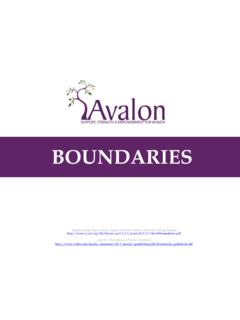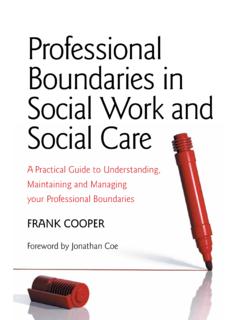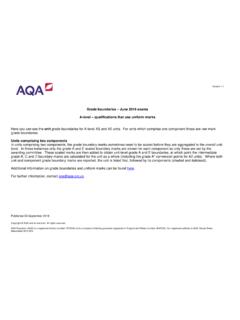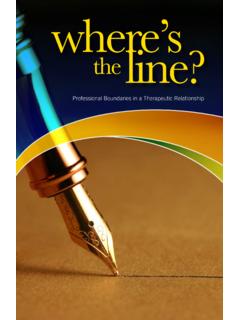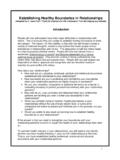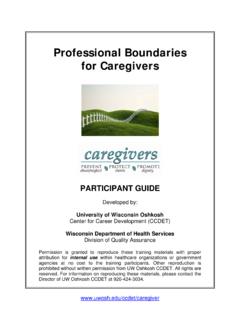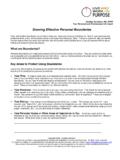Transcription of MAINTAINING PROFESSIONAL BOUNDARIES AND …
1 MAINTAINING PROFESSIONAL BOUNDARIES AND preventing SEXUAL ABUSE. Registered Massage Therapists ( RMTs , MTs or registrants ) work with clients for therapeutic purposes. As regulated health professionals, RMTs are required to maintain PROFESSIONAL BOUNDARIES at all times. Understanding the importance of BOUNDARIES and respecting BOUNDARIES is critical to the prevention of abuse and sexual abuse in particular. This Standard is divided into two parts: A) MAINTAINING PROFESSIONAL BOUNDARIES , and B). preventing Sexual Abuse. Definitions are available at the end of this document. Part A: MAINTAINING PROFESSIONAL BOUNDARIES MTs work with clients to establish a purposeful treatment program. This process includes several phases: an interview to gain an understanding of treatment goals; assessing the client's history; and obtaining informed consent for the assessment, and, if indicated, a treatment plan.
2 Throughout assessment and treatment, the MT maintains a therapeutic relationship. The MT is respectful and works with the client in following the agreed upon structured and intentional treatment plan to meet client needs and goals. Through the processes of obtaining informed consent, completing a thorough assessment, and implementing an appropriate treatment plan, the MT establishes PROFESSIONAL BOUNDARIES and maintains a therapeutic relationship built on mutual trust and respect. Standard A1: Establishing a Practice Setting that Maintains PROFESSIONAL BOUNDARIES The therapeutic relationship begins with the client's experience of the Massage Therapy practice setting which should be consistent with the public's expectations for an appointment with a healthcare PROFESSIONAL .
3 Where the setting is a public space or a mobile practice, the MT. must take reasonable steps to ensure professionalism in the practice setting. Registrants must ensure the practice setting for Massage Therapy: Remains clean, organized and that Public Health Infection Control measures are observed at all times. Provides lighting to ensure client safety. Is free from potential hazards for injury. Respects individual needs related to allergies and sensitivities ( scent, mould and dust-free). Adequately provides for client privacy and confidentiality as required throughout the stages of the client appointment. Standards for MAINTAINING PROFESSIONAL BOUNDARIES and preventing Sexual Abuse September 2017. 1. Video or photographic recording equipment is used with informed consent from the client for assessment, treatment, and educational purposes only.
4 Securing and storing of these images must comply with all Standards of Practice and legislative requirements for documentation, storage, and maintenance of client records. Devices with video or photographic functions that are not being used for the purposes of recording/photographing ( device for client charting/records, playing music) will have these recording functions inactive or blocked while the client is present. Ensures that any visual media or messaging accessible to clients or members of the public is appropriate and is not of a sensitive, discriminatory or offensive nature. Standard A2: Interpersonal Behaviours and Non-Verbal Communication Interpersonal behaviour and non-verbal communication are significant to setting PROFESSIONAL BOUNDARIES within the Therapeutic Relationship.
5 The MT must maintain PROFESSIONAL behaviour toward clients at all times. The MT must also refrain from behaviours, remarks or physical gestures that increase the risk of boundary violations. Registrants must ensure PROFESSIONAL behaviour, body language and gestures by: Wearing attire appropriate to health care professionals and the context of the work environment. Engaging in appropriate personal hygiene practices. Providing adequate physical boundary space between the therapist and client at all stages of the client appointment. Physical touch or contact only in the context of assessment and treatment processes for which the client has given informed consent. Identify and recognize any client non-verbal' communication cues and address respectfully.
6 If a client initiates a hug, the MT must consider the intent ( appreciation or sexual). prior to engaging. Hugging is not to be initiated by the MT. Standard A3: Verbal Communication to Maintain PROFESSIONAL BOUNDARIES An important part of any therapeutic relationship is communication. Communication must be respectful, PROFESSIONAL , and appropriate to a health care environment. In communicating to maintain PROFESSIONAL BOUNDARIES , registrants must: Standards for MAINTAINING PROFESSIONAL BOUNDARIES and preventing Sexual Abuse September 2017. 2. Ensure the client remains appropriately informed of all assessment and treatment processes and plans through obtaining informed consent in accordance with PROFESSIONAL regulations and standards.
7 Verify client consent throughout the assessment and treatment processes, as appropriate, to ensure client comfort and safety. Provide the client with the opportunity to ask questions at any point in the treatment or treatment plan. Use language that is respectful, courteous, and non-sexual in nature. Respect client culture and diversity. Restrict inquiry to content relevant to assessment and treatment, and focus personal disclosure of information on that which furthers the therapeutic relationship. Set and maintain appropriate BOUNDARIES in conversation at all times. The MT is responsible for helping clients recognize when a request or MT disclosure is outside of the therapist- client relationship and the Massage Therapy Treatment Plan.
8 Standard A4: Draping One of the ways MTs establish and maintain physical BOUNDARIES in the therapeutic relationship is through appropriate and secure draping measures or techniques. When appropriately applied and monitored throughout treatment, draping can ensure the client's sense of physical privacy and safety, and builds the respect and trust inherent in the therapeutic relationship. When inappropriately or inadvertently applied, poor draping can result in boundary violations and instances of physical, emotional or sexual abuse. When applying draping techniques, MTs must: Ensure they have properly informed the client of the draping requirements associated with assessment and treatment prior to beginning assessment or treatment processes.
9 Explain clearly to the client the regions of the body to which the MT will be applying manual assessment or treatment applications, and whether the applications will be directly on skin or through clothing. Explain to the client how to prepare for assessment and treatment, including the option to remove clothing as well as the option to remained clothed and how to position themselves for assessment/treatment. Confirm client comfort when treatment is performed over clothing. Provide opportunities for clients to ask questions. Standards for MAINTAINING PROFESSIONAL BOUNDARIES and preventing Sexual Abuse September 2017. 3. Apply necessary draping measures securely to engage in setting clear physical BOUNDARIES that separate the areas of treatment and the areas where no touch will be applied throughout the assessment and treatment.
10 Verify client safety, sense of security and comfort level with draping/positioning measures. Ensure that only the area of the client's body that is actively receiving assessment or treatment is uncovered, with the exception of the face and head. At the request of the client, expose areas of the body that are not considered sensitive areas when not receiving treatment for the purposes of temperature regulation or client preference ( arms, feet or back). Ensure client informed consent is obtained where treatment requires bilateral undraping ( lymphedema treatment). Ensure that the MT does not reach underneath the draping. Standard A5: Treating Family or Friends Certain situations create the need for extra vigilance in the maintenance of BOUNDARIES .




